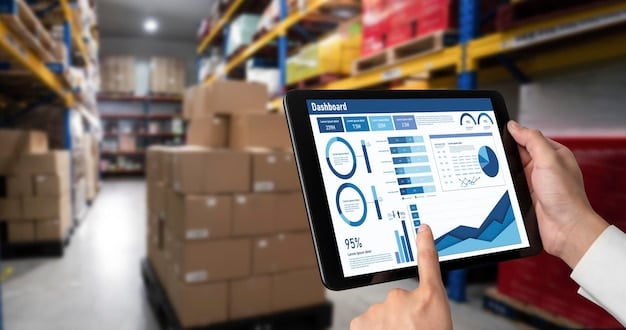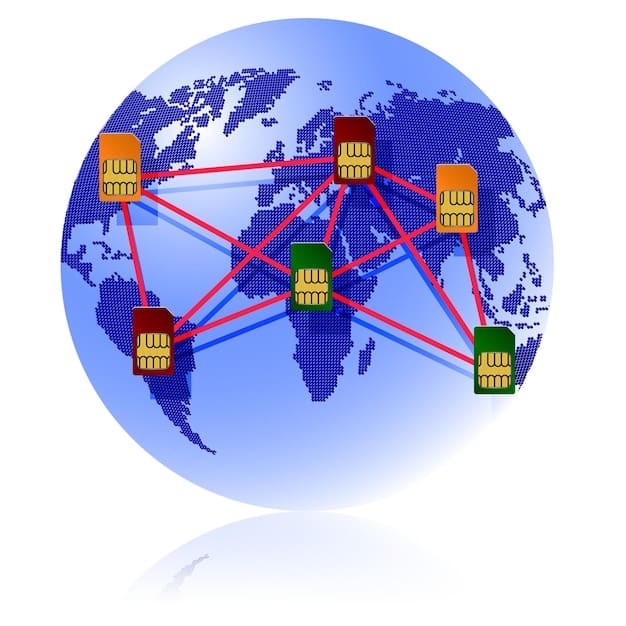E-commerce Supply Chain Investments: Maximize Returns, Minimize Risk

E-commerce supply chain investments are critical for mitigating risk and maximizing returns by optimizing logistics, technology, and partnerships to enhance efficiency and resilience.
Investing in the **e-commerce supply chain** is crucial for businesses looking to mitigate risks and maximize returns in today’s dynamic market.
Understanding the E-commerce Supply Chain Landscape
The e-commerce supply chain is the backbone of online retail, encompassing everything from sourcing raw materials to delivering products to customers. It’s a complex network that requires careful management and strategic investment to ensure efficiency and profitability.
Understanding the intricacies of this landscape is the first step toward making informed investment decisions. Factors such as globalization, technological advancements, and changing consumer expectations all play a significant role in shaping the modern e-commerce supply chain.
Key Components of the E-commerce Supply Chain
The e-commerce supply chain consists of several key components, each of which presents unique investment opportunities. These include:
- Sourcing and Procurement: This involves identifying and selecting suppliers, negotiating contracts, and managing inventory levels.
- Warehousing and Distribution: Efficient warehousing and distribution networks are essential for fulfilling orders quickly and accurately.
- Transportation and Logistics: Moving goods from suppliers to warehouses and ultimately to customers requires a robust transportation and logistics infrastructure.
- Technology and Software: Technology plays a critical role in optimizing every aspect of the e-commerce supply chain.

These components are interconnected and must work together seamlessly to ensure the smooth flow of goods and information. Investments in these areas can lead to significant improvements in efficiency, cost savings, and customer satisfaction.
Risk Assessment in E-commerce Supply Chains
E-commerce supply chains are exposed to a variety of risks, ranging from disruptions in the supply of raw materials to cyberattacks. A thorough risk assessment is essential for identifying potential vulnerabilities and developing strategies to mitigate them.
By understanding the types of risks that can impact their supply chains, businesses can make informed decisions about where to allocate resources and implement proactive measures to minimize potential disruptions.
Types of Risks in E-commerce Supply Chains
Several types of risks can impact e-commerce supply chains, including:
- Supply Disruption: Disruptions in the supply of raw materials or finished goods can have a significant impact on a business’s ability to fulfill orders.
- Transportation Delays: Delays in transportation can lead to missed delivery deadlines and dissatisfied customers.
- Cybersecurity Threats: E-commerce businesses are increasingly vulnerable to cyberattacks that can compromise sensitive data and disrupt operations.
- Geopolitical Instability: Political instability in certain regions can disrupt supply chains and create uncertainty.
Addressing these risks requires a multi-faceted approach that includes risk management strategies, contingency plans, and ongoing monitoring.
Strategies for Mitigating Supply Chain Risks
Mitigating supply chain risks requires a proactive and strategic approach. Businesses can implement a variety of strategies to minimize potential disruptions and ensure business continuity.
These strategies should be tailored to the specific risks that a business faces and should be regularly reviewed and updated to reflect changing market conditions.
Key Risk Mitigation Strategies
Some key risk mitigation strategies include:
- Diversifying the Supply Base: Relying on a single supplier can create vulnerability. Diversifying the supply base can reduce the impact of disruptions at any one supplier.
- Building Inventory Buffers: Maintaining sufficient inventory levels can help to cushion the impact of supply disruptions and transportation delays.
- Investing in Cybersecurity: Protecting sensitive data and systems from cyberattacks is essential for maintaining business continuity.
- Developing Contingency Plans: Having contingency plans in place for various scenarios can help to minimize the impact of disruptions.
By implementing these strategies, businesses can enhance the resilience of their supply chains and minimize the impact of potential disruptions.
Leveraging Technology for Supply Chain Optimization
Technology plays a critical role in optimizing e-commerce supply chains. From advanced analytics to automation, technology can help businesses improve efficiency, reduce costs, and enhance customer satisfaction.
Investing in the right technology can provide a competitive edge and enable businesses to adapt quickly to changing market conditions.
Technological Advancements in Supply Chain Management
Several technological advancements are transforming the e-commerce supply chain, including:
- Artificial Intelligence and Machine Learning: AI and machine learning can be used to predict demand, optimize inventory levels, and improve logistics.
- Blockchain Technology: Blockchain can enhance transparency and traceability in the supply chain, reducing the risk of fraud and counterfeit products.
- Internet of Things (IoT): IoT devices can provide real-time data on the location and condition of goods, enabling better monitoring and control.

These technologies can help businesses to streamline operations, improve decision-making, and create a more agile and responsive supply chain.
Maximizing Returns on Supply Chain Investments
Maximizing returns on supply chain investments requires a focus on efficiency, innovation, and customer satisfaction. Businesses need to carefully evaluate potential investment opportunities and prioritize those that offer the greatest potential for return.
Regular monitoring and evaluation of key performance indicators (KPIs) are essential for tracking progress and identifying areas for improvement.
Key Strategies for Maximizing Returns
Some key strategies for maximizing returns on supply chain investments include:
- Focusing on Customer Experience: A positive customer experience can lead to increased loyalty and repeat business.
- Driving Efficiency: Streamlining processes and reducing waste can lead to significant cost savings.
- Embracing Innovation: Investing in new technologies and innovative solutions can provide a competitive edge.
By focusing on these strategies, businesses can ensure that their supply chain investments generate significant returns and contribute to long-term success.
Future Trends in E-commerce Supply Chain Investments
The e-commerce supply chain is constantly evolving, and businesses need to stay abreast of emerging trends to remain competitive. Several trends are expected to shape the future of e-commerce supply chain investments.
Understanding these trends can help businesses to make informed decisions about where to allocate resources and develop strategies for long-term success.
Emerging Trends in E-commerce Supply Chains
Some emerging trends in e-commerce supply chains include:
- Sustainability: Consumers are increasingly demanding sustainable products and practices, and businesses need to invest in eco-friendly supply chain solutions.
- Localization: Businesses are increasingly focusing on localizing their supply chains to reduce transportation costs and improve responsiveness.
- Resilience: Building resilient supply chains that can withstand disruptions is becoming increasingly important.
By embracing these trends, businesses can create more sustainable, responsive, and resilient supply chains that are well-positioned for the future.
In conclusion, strategic e-commerce supply chain investments are essential for mitigating risk and maximizing returns in today’s competitive market. By understanding the landscape, assessing risks, leveraging technology, and focusing on customer satisfaction, businesses can build robust and efficient supply chains that drive growth and profitability.
| Key Aspect | Brief Description |
|---|---|
| 📦 Inventory Management | Optimizing stock levels to meet demand without overstocking. |
| 🚚 Logistics Efficiency | Streamlining transportation routes and delivery times. |
| 🛡️ Risk Mitigation | Strategies to minimize disruptions in the supply chain. |
| 📊 Technology Adoption | Integrating AI, blockchain, and IoT for better tracking and efficiency. |
Frequently Asked Questions
▼
The e-commerce supply chain encompasses all activities required to get a product from sourcing to delivery, including procurement, warehousing, and logistics.
▼
Risk assessment identifies potential vulnerabilities like supply disruptions and cyber threats, helping businesses prepare and minimize impacts.
▼
Technology like AI and IoT can enhance tracking, predict demand, and automate processes, leading to greater efficiency and cost savings.
▼
Focusing on customer experience, streamlining operations for efficiency, and adopting innovation are key to maximizing returns from investments.
▼
Sustainability, localization, and building resilience are crucial for future-proofing e-commerce supply chains and aligning with consumer demands.
Conclusion
Investing wisely in the e-commerce supply chain, with a keen focus on mitigating risks and optimizing returns, is paramount for sustained growth and competitiveness in the evolving digital marketplace. By adopting strategic approaches and leveraging innovative technologies, businesses can build resilient and efficient supply chains that drive profitability and enhance customer satisfaction.





